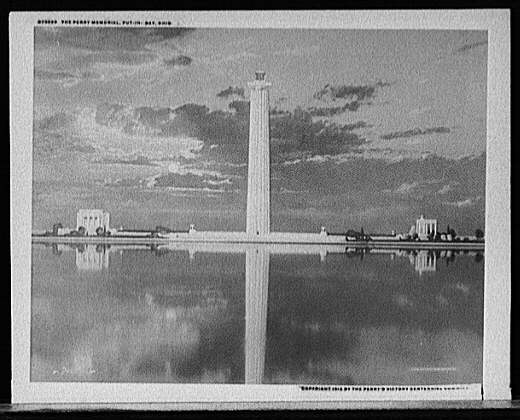SW, May 1998

Cultural Geography
The Perry's Victory and International Peace Memorial and the USS Arizona Memorial commemorate vastly different periods in American history, but they both remember the men who died in specific battles. Where one is dedicated to peace, the other seems to suggest constant vigilance against future attacks. With these similarities and differences in mind, we will explore the meanings of these two memorials and the locations in which they were built.
Perry's Victory and International Peace Memorial
| Modern meanings of the Memorial are also closely tied to the island as a summer resort.
Since the mid-1800s, many day trippers and vacationers made Put-in-Bay their destination. With the addition
in the past ten years of faster boat service to the island from nearby Port Clinton, Sandusky, and Cleveland, many
people from northern Ohio can easily visit the island and its attractions. Visitors come to see the winery, geological
formations, as well as the locally famous bars and restaurants. Most visitors to the Island probably visit the
Memorial more for its spectacular view from the observation deck than to learn about the island's history. Although
the Memorial was built long after Put-in-Bay became a summer resort, the changing nature of the village in the
past 30 to 40 years, with its growing tourist trade, has obscured its original meaning. The monument now serves
less as an historical marker for the Great Lakes area than as the backdrop for commercialized leisure activities. SW, May 1998 |
 |
|
Return home to: |
More info about Perry Memorial |
Return home to: |
| Located in Pearl Harbor, Honolulu, Hawaii, the USS Arizona Memorial is a reminder of the importance Pearl Harbor played as a military target. In 1941, Pearl Harbor housed the U.S. Pacific Fleet. Twenty-one ships of this fleet were either laid to rest or damaged during the Japanese attack of Pearl Harbor, December 7, 1941. To this day Pearl Harbor is one of the world's largest naval bases. It is fitting then that the Memorial which serves as both a grave site for the fallen members of the Arizona as well as a symbol of naval might is located in Pearl Harbor rather than Washington D.C. | ||
The Pearl Harbor complex stands today as a reminder of America's vulnerability to attack and to its arduous struggle for peace in the Pacific during World War II. On that fateful Sunday morning, Japanese forces killed 1,177 members of the Arizona. Over fifty years later, the Arizona still lies in shallow waters where it was anchored on that day in Honolulu, Hawaii. |
Since the Arizona is still visible to the Memorial's visitors, the viewers experience is directly connected to the devastation of war. Though it is located in Hawaii, 1.5 million people visit the siteannually, 30% of whom are foreign visitors. Run by the National Park Service since 1980, the Memorial is free to all. Critics of the Memorial believe its mission has become lost due to its large volume of tourist traffic. |
|
A typical visit to the USS Arizona Memorial is a structured experience that lasts two and a half hours. The first part of the exhibit -- the interpretive program -- consists of a short talk by either a National Park Service ranger or a Pearl Harbor survivor. Next, the visitor watches a 23-minute documentary film on the Pearl Harbor attack. A Navy boat then shuttles the visitors from the Visitor Center to the Memorial. Once aboard the USS Arizona Memorial, visitors spend a lengthy amount of time on the structure. The memorials siting over the sunken war ship provides, at once, a space for public commemoration and private reflection. GM, May 1998 |
||
|
Return home to |
More information about the USS Arizona |
Return home to |